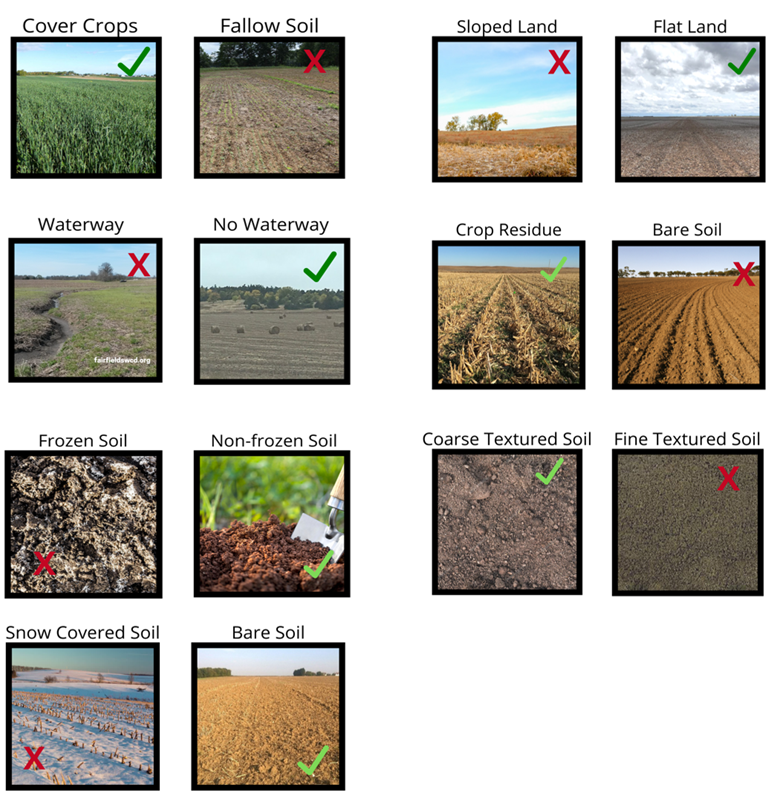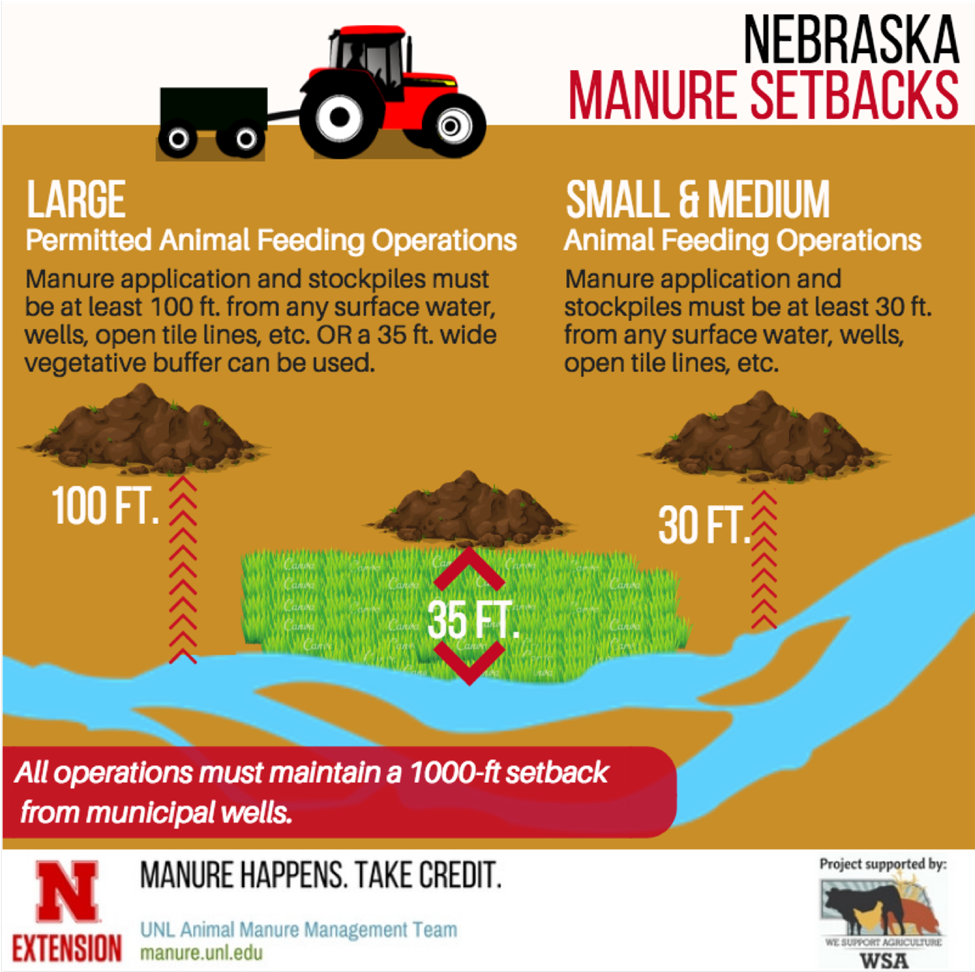By: Javed Iqbal & Amy Millmier Schmidt
A blanket of fresh white snow and icicles hanging from the trees and fences make for beautiful winter photos. They don’t, however, make for beautiful manure application weather.
One of the key rules of manure management is to pump and spread manure whenever weather and field conditions allow so that you can maintain storage capacity in case of inclement weather. Unfortunately, “perfect manure application weather” is rare and seldom lasts as long as you need it to. So, if you’re heading into winter with a manure storage that hasn’t been pumped down as much as it needs to be, consider these tips when planning for application.
Where to Apply

If possible, avoid applying manure on fields with slopes; sloped land presents a greater risk for erosion and runoff (See Figure 1). Consider applying manure on the more level ground, well away from ditches or water bodies (Follow Setbacks in Figure 2). Try to apply manure on ground having at least 30% crop residue cover as this reduces the chances of manure runoff during the heavy precipitation events and snowmelt. Compared to fine textured soils, choose coarse texture soil for manure application as sandy soils have more infiltration rate and reduces the chances of nutrients runoff. Planting cover crops in fields used for manure application also reduces the risk for nutrient runoff losses (See Figure 1). Cover crops also reduce the risk for nitrate leaching since the plants use applied nutrients during growth; further, they release stored nutrients into the soil during their decomposition in the summer growing season.
For permitted livestock operations, a Phosphorus Index should have been completed for all fields receiving manure. This assessment of risk to surface water can also be used to identify lower-risk fields for winter emergency applications. Check with your advisor or contact the UNL manure team for how your P-Index might be used for this purpose.
When to Apply
It is best practice to apply manure outside of winter when the soil is dry and there is less risk of potential nutrient loss (See Figure 1). However, application of manure during winter months can be accomplished with low risk for runoff when certain conditions are met. In general, manure application should be avoided when fields are snow covered. If manure application cannot be avoided when soil is frozen or snow-covered, it is critical to recognize the runoff risks associated with solid vs. liquid manures before making manure application decisions.

Application of liquid manure to soil that is frozen beyond the top layer is not recommended as this poses a high risk of nutrient loss through runoff. However, if conditions cause soil to freeze overnight and thaw during the day, application will likely create little risk for nutrient runoff and compaction may be lessened by applying liquid manure in the morning before the soil thaws. If a liquid storage is at risk of topping a berm, multiple light applications of liquid over time is preferable to a single, larger application on frozen soil. Constant monitoring of the application field(s) for runoff is necessary so that application can be discontinued if runoff occurs. As long as a storage is not at risk of topping the berm, liquid application should be delayed until runoff risks decrease.
For solid manures, application to frozen soil can likely be accomplished with little risk of runoff when precipitation is not predicted and application site selection follows the recommendations in the “Where to Apply” section of this article.
With any manure application planning, monitor the ten-day forecast and avoid applying manure before possible major precipitation events to avoid potential nutrient runoff.
How to Apply
First and foremost, regardless of the time of year, manure application should be done such that nutrients applied never exceed the needs of the crops and soils receiving them. Sampling and testing soils and manure sources to determine their nutrient characteristics is critical in determining the maximum rate of manure application and preferably staying below this rate during the frozen soil conditions.
Lower than normal precipitation throughout much of Nebraska in 2023 might have led to increased residual nitrate-nitrogen concentrations in some soils. Furthermore, repeated manure application on a field without testing soil can result in a buildup of soil phosphorus, which increases the risk of phosphorus losses to surface water during runoff and erosion. So, consider testing soil and manure nutrient concentrations, and credit nutrients in your nutrient budgets before you spread manure on your field.
Alternatives to the Best Laid Plan
What happens when, despite your best efforts, your manure storage is full and you have to apply manure to prevent a discharge? Contact your regional Nebraska Department of Environment and Energy Field Office for guidance. If your situation is the result of excessive precipitation that has prevented pumping and application of manure, it is important to select application sites having the lowest risk for runoff from the saturated soil. These include fields with little to no slope, those containing vegetation or crop residue, and sites that are as far as possible from waterways (See figures 1 and 2).
Key Points
Manure application during winter can be a difficult management decision. Application of manure on the frozen or snow-covered ground can lead to significant nutrient loss impacting surface and ground water quality. The nutrient loss can be avoided by following a manure management plan with the right conditions of manure application. While permitted animal feeding operations (AFOs) should consult their Nutrient Management Plan in their permit for guidance on winter manure application, farms not operating under a permit still have an obligation to handle manure responsibly.
Consider the following points when making winter manure application decisions about where, when and how to apply manure. And, when in doubt, consult the NDEE, NRCS or your local Extension educator for guidance.
- Test your soil and manure nutrient concentrations to guide your decision on where manure should be applied.
- When multiple application sites are available, choose drier fields over wetter fields, flatter sites over sloped sites, land with vegetation or crop residue rather than bare soil, coarse-textured soils over light-textured soils, and land as far from surface water as possible (See Figures 1 and 2).
- Avoid manure application for at least 24 hours before a forecasted precipitation event, preferably longer, to minimize the risk for nutrient runoff.
- Avoid applying liquid manure at a rate that exceeds the infiltration rate of the soil.
- Follow state-required setbacks (Figure 2) from surface water (e.g. bed and bank streams, wetlands, lakes etc.) during all manure applications (not just winter!).
- When in doubt about the rate, method, location or timing of manure application, seek guidance from trusted and knowledgeable experts.





